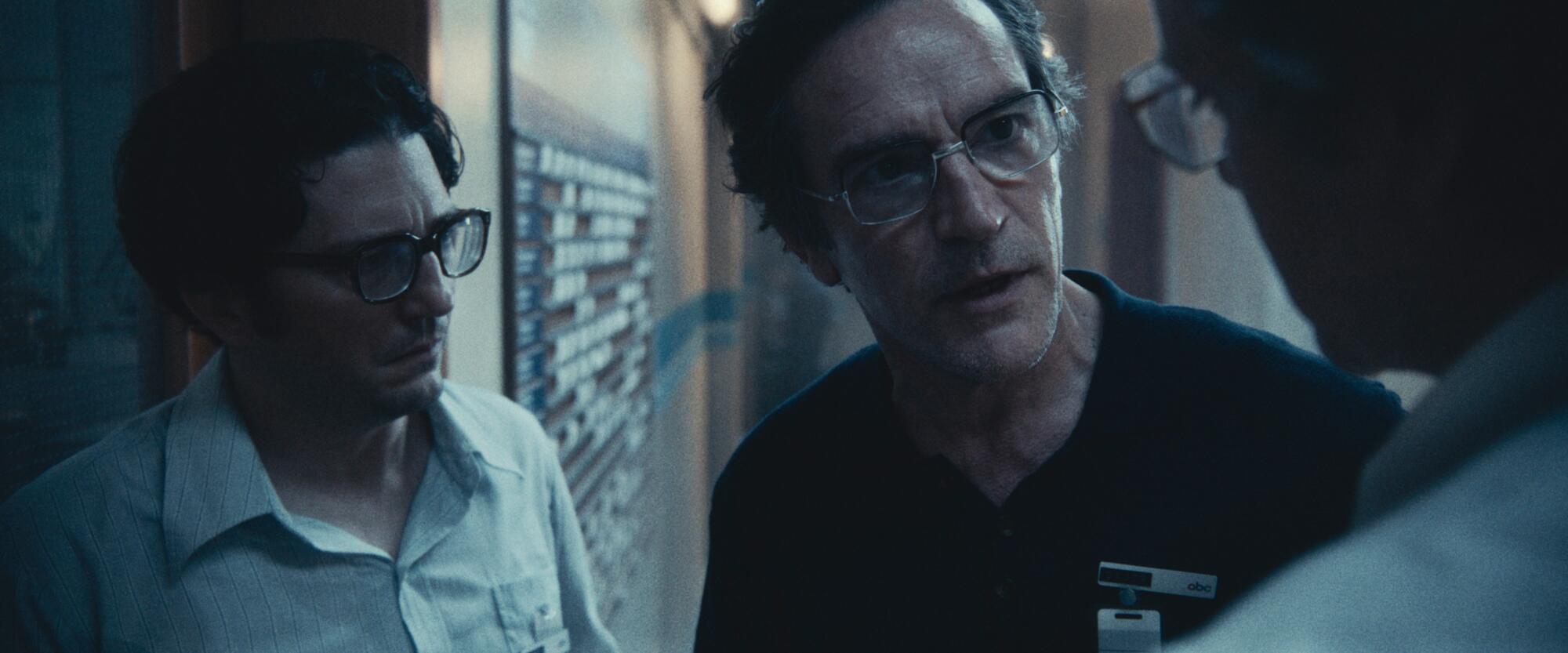
- Share via
When John Magaro was eyeballing acting as a living and soaking up ’70s movies in college, Dustin Hoffman’s career looked awfully inspiring. (“Ethnic, short,” Magaro cracks.) So when “September 5” came along with the role of real-life TV producer Geoffrey Mason, an instrumental figure in ABC Sports’ groundbreaking spot-news coverage of the 1972 Munich Summer Olympics terrorist attack, reading the script gave Magaro a flash of one of those gritty, in-the-moment docudramas he cherished from that earlier era.
“I saw ‘All the President’s Men’ in this,” says Magaro, “and my chance to step into Dustin Hoffman’s shoes a bit, so I was excited to do that.”
A sports broadcaster thrown into an unpredictable hard-news situation when terrorists take Israeli Olympic team members hostage and later kill them, Mason is the audience’s entry point into a situation where the latest live TV technology could beam to millions of viewers simultaneously, but those making decisions had to grapple with ethical quandaries new to the medium. Mason’s recollections, which Magaro corroborated through other accounts (such as those by the late ABC anchor Jim McKay’s son, Sean McManus, a teenager at the time), were invaluable source material about the day’s intensity.
“It was a moment that changed news forever,” says Magaro. “They were focused, they had to stay on the air. There was no time for emotions, to wallow or get freaked out or anxious. It was just, ‘Do your job.’ It made it very clear what I needed to do, which was learn how to be a producer and director.”
The new thriller ‘September 5’ looks back at the 1972 Munich Olympics tragedy through the lens of ABC’s coverage, exploring the ethical dilemmas of crisis reporting.
For months, Magaro watched CBS teams call football and basketball games, absorbing their world. (“You realize it’s a whole other language, very precise,” he notes.) Director Tim Fehlbaum then secured archival footage from the day and had other footage re-created, so that in the control room set they’d built in Munich, Magaro-as-Mason could “call” the broadcast live, as if, say, the McKay from that day in 1972 were genuinely reacting to him in another room. Another on-set reality: vintage technology — phones, headsets, walkie-talkies, monitors, cameras — that really worked.
“I’ve had to learn piano in a movie, I’ve learned drums for David Chase, and it reminded me of those experiences,” says the actor, who played Douglas in “Not Fade Away.” “It was really important to get my hands on [that equipment] as soon as possible so I could practice, get comfortable and let the walkie-talkie be an extension of my limbs. In those rooms, they didn’t stumble over that stuff.”
Magaro got so comfortable at calling the shots on camera that his producing performance impressed Mason himself. “He was over the moon when he saw it,” says Magaro, who got similar pats on the back from veteran ABC broadcasters when the film was shown to them. “They felt like they were in a time portal. ‘That’s what it was.’ That’s pretty cool.”

Films such as ‘Schindler’s List’ and ‘Gentleman’s Agreement’ have won top Oscar gold. But how will the range of Jewish-centric films fare this awards season?
With Fehlbaum shooting in long takes, the cast never knew with each run-through where the handheld cameras might be pointed, in what came to be called “wild style” shooting. This meant Magaro and co-stars Peter Sarsgaard, Ben Chaplin and Leonie Benesch had to be on their toes.
“We were game for it, because all of us came from theater, so we were like a company,” says Magaro. “It makes you unaware of the camera, and there’s a liberation in not worrying about it. It frees you up for an authentic performance, something you maybe wouldn’t have been able to do if you know the camera’s on you. Nothing felt forced. Silences felt earned.”
They were storytellers playing storytellers, which fostered an ongoing conversation about finding the right tone and language that mirrored what their characters were doing. “We didn’t want much of a difference between when the camera was rolling or when it was off,” says Magaro. “Tim was never like, ‘You have to do it this way.’ We were figuring things out. It was really shedding the masks that actors put on. It’s challenging, but it’s a fun exercise.”

“We didn’t want much of a difference between when the camera was rolling or when it was off... We were figuring things out. It was really shedding the masks that actors put on. It’s challenging, but it’s a fun exercise.”
— John Magaro
“September 5” was filmed before last year’s Oct. 7 Hamas attack on Israel, and recent events might affect the way audiences perceive the way the Israeli-Palestinian conflict is depicted in the period movie. But Magaro hopes people don’t come in with preconceived notions about what the film is. “It’s not about choosing sides, or even being apolitical,” he says. “It’s examining how media has changed, and ethical questions regarding the media. Our focus was this story.”
Ultimately, making a film about the impact of what’s chosen to be shown to millions of people had an effect on how Magaro has consumed media since. “I used to be much more of a 24-hour news junkie, and this has made me step back and really consider the sources of news I’m taking in,” he says. “I had become desensitized to tragedy in a way, and I hope this movie makes people question that.”
More to Read
From the Oscars to the Emmys.
Get the Envelope newsletter for exclusive awards season coverage, behind-the-scenes stories from the Envelope podcast and columnist Glenn Whipp’s must-read analysis.
You may occasionally receive promotional content from the Los Angeles Times.










